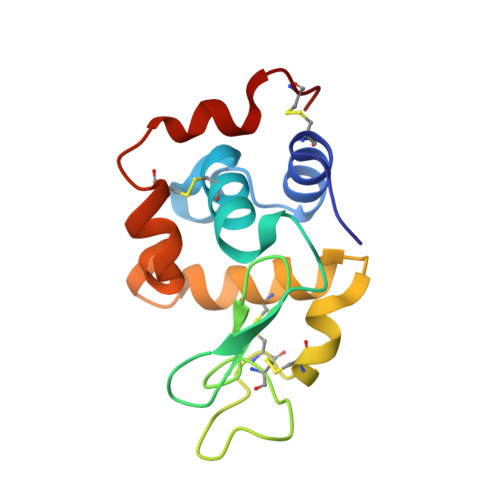Ru-Based CO releasing molecules with azole ligands: interaction with proteins and the CO release mechanism disclosed by X-ray crystallography.
Pontillo, N., Ferraro, G., Messori, L., Tamasi, G., Merlino, A.(2017) Dalton Trans 46: 9621-9629
- PubMed: 28702564
- DOI: https://doi.org/10.1039/c7dt01991b
- Primary Citation of Related Structures:
5OB6, 5OB7, 5OB8, 5OB9, 5OBC, 5OBD, 5OBE - PubMed Abstract:
fac-[Ru II (CO) 3 Cl 2 (N 3 -Imidazole)] (Ru II IM), fac-[Ru II (CO) 3 Cl 2 (N 3 -methyl-imidazole)] (Ru II MIM) and fac-[Ru II (CO) 3 Cl 2 (N 3 -methyl-benzimidazole)] (Ru II MBI) are three ruthenium based CO releasing molecules (Ru-CORMs) that are cytotoxic towards ovarian and colon carcinoma cell lines. Detailed structural information on the adducts formed upon reaction of Ru II IM and Ru II MIM with hen egg white lysozyme and of the three Ru-CORMs with bovine pancreatic ribonuclease is provided here by X-ray crystallography. Comparative analysis of seven crystal structures of these adducts allows one to delineate some general trends in the reactivity of these Ru-CORMs with proteins. Indeed, in all cases Ru-CORMs bind these model systems upon detachment of the azole ligand and concomitant coordination to a protein His or Asp residue. Apparently the three Ru-CORMs progressively dissociate losing azoles, chlorides, and one or two CO molecules. Data were compared with those reported in the literature for adducts of the same proteins with other Ru-CORMs and with in-solution data previously obtained on the same systems. These results are potentially useful for a better understanding of the chemistry, potential toxicity and mechanism of actions of these interesting Ru-CORMs and are helpful in defining the molecular mechanisms of CO release.
- Department of Chemical Sciences, University of Naples Federico II, Complesso Universitario di Monte Sant' Angelo, Via Cinthia, I-80126, Napoli, Italy. antonello.merlino@unina.it.
Organizational Affiliation:



















